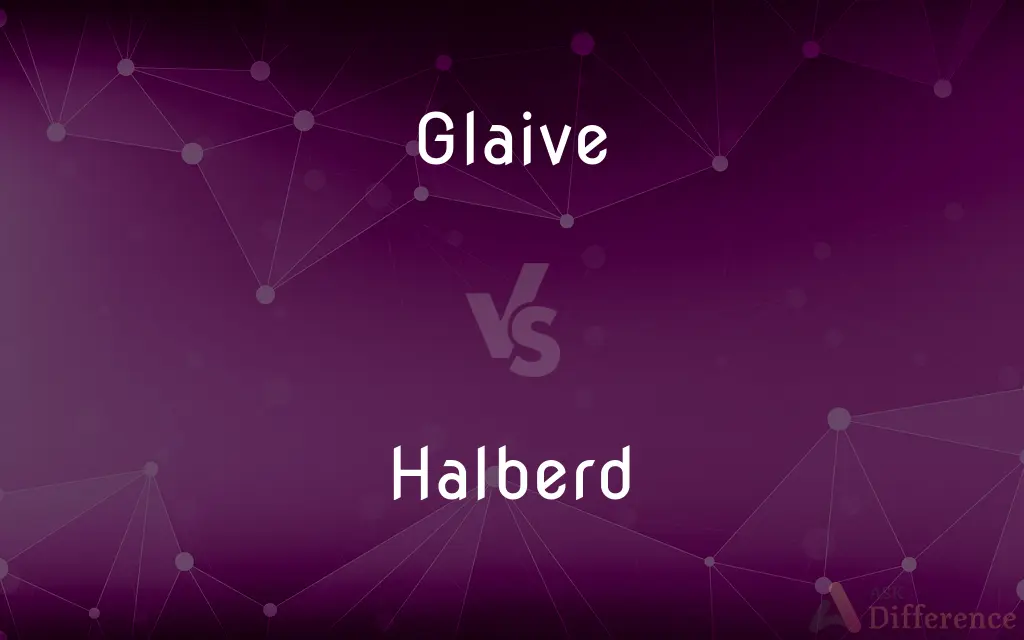Glaive vs. Halberd — What's the Difference?
By Tayyaba Rehman & Maham Liaqat — Updated on April 3, 2024
Both are polearms, but a glaive has a single-edged blade for slashing, while a halberd combines a spear point, axe blade, and hook.

Difference Between Glaive and Halberd
Table of Contents
ADVERTISEMENT
Key Differences
The glaive and halberd are both medieval polearms used by foot soldiers against cavalry and infantry. The glaive features a long, single-edged blade mounted on a pole, designed primarily for slashing at opponents. Its blade is similar to a knife or sword, making it effective for cutting through enemy lines. Conversely, the halberd is a more versatile weapon, combining a spear point for thrusting, an axe blade for cutting, and sometimes a hook for pulling riders from their mounts. This multifunctional design made the halberd a Swiss army knife of medieval weaponry.
While the glaive emphasizes reach and slashing capability, allowing soldiers to keep enemies at a distance while inflicting severe cuts, the halberd's design is strategic for both offense and defense. The halberdier could thrust at opponents with the spear point, chop with the axe blade, and use the hook to dismount cavalry. This versatility made the halberd particularly effective in various combat situations, from individual duels to large-scale battles.
The use of the glaive can be seen as more specialized due to its design focusing on slashing. Its long blade required significant skill to use effectively, particularly in maintaining momentum and maneuvering the weapon. In contrast, the halberd's design allowed for a broader range of techniques and strategies, making it accessible to a wider range of soldiers with varying skill levels.
In terms of historical significance, both weapons reflect the evolution of medieval warfare and the need for foot soldiers to counter the threat posed by heavily armored cavalry. However, the halberd, with its multifunctionality, represents a significant development in polearm technology, offering soldiers a more adaptable weapon for the changing dynamics of medieval battlefields.
While both the glaive and the halberd fell out of use with the advent of gunpowder and modern firearms, their impact on medieval military tactics and their iconic status in historical and fantasy literature and media remain significant. Today, they are often studied for their historical value and replicated for martial arts, reenactments, and collectors.
ADVERTISEMENT
Comparison Chart
Design
Long, single-edged blade for slashing
Spear point, axe blade, and hook
Primary Use
Slashing at enemies
Versatile: thrusting, cutting, and pulling
Handling
Requires skill for effective slashing
Allows for a range of techniques
Historical Use
Anti-infantry, maintaining distance
Anti-cavalry, versatile in combat
Significance
Specialized for cutting through enemy lines
Strategic versatility in warfare
Compare with Definitions
Glaive
A polearm with a long, single-edged blade.
The knight wielded a glaive to slash through the advancing foes.
Halberd
Versatile medieval weapon for various combat techniques.
With his halberd, the soldier could thrust, chop, and pull down horsemen.
Glaive
A medieval weapon for slashing.
In the museum, the ancient glaive stood as a testament to the era's warfare.
Halberd
Used for strategic advantage in warfare.
The versatility of the halberd gave its users a strategic edge in close combat.
Glaive
Used primarily by foot soldiers.
Foot soldiers trained with the glaive to fend off cavalry charges.
Halberd
Incorporates elements for thrusting and cutting.
The halberd's design allowed for both piercing armor and delivering deadly cuts.
Glaive
Focused on cutting and slashing.
The sharp edge of the glaive was designed for powerful slashing motions.
Halberd
Effective against both infantry and cavalry.
The halberd proved its effectiveness on the battlefield against multiple foes.
Glaive
Characterized by its blade's reach.
The glaive's reach gave the wielder a significant advantage in combat.
Halberd
A polearm combining an axe, spike, and sometimes a hook.
The halberdier stood ready, halberd in hand, to face the enemy cavalry.
Glaive
A glaive (or glave) is a European polearm, consisting of a single-edged blade on the end of a pole. It is similar to the Japanese naginata, the Chinese guandao and pudao, the Korean woldo, the Russian sovnya, and the Siberian palma.
Halberd
A halberd (also called halbard, halbert or Swiss voulge) is a two-handed pole weapon that came to prominent use during the 14th, 15th, and 16th centuries. The word halberd is most likely equivalent to the German word Hellebarde, deriving from Middle High German halm (handle) and barte (battleaxe) joined to form helmbarte.
Glaive
A sword, especially a broadsword.
Halberd
A combined spear and battleaxe.
Glaive
A light lance with a long, sharp-pointed head.
Halberd
A weapon of the 1400s and 1500s having an axelike blade and a steel spike mounted on the end of a long shaft.
Glaive
(historical) A weapon consisting of a pole with a large blade fixed on the end, the edge of which is on the outside curve.
Halberd
A two-handed pole weapon, consisting of a long pole with an axe-like blade mounted on it (at a right angle like an axe, not on the tip like a spear), and (opposite the blade) typically a spike or hook.
Glaive
A sword, particularly a broadsword.
Halberd
An ancient long-handled weapon, of which the head had a point and several long, sharp edges, curved or straight, and sometimes additional points. The heads were sometimes of very elaborate form.
Glaive
A weapon formerly used, consisting of a large blade fixed on the end of a pole, whose edge was on the outside curve; also, a light lance with a long sharp-pointed head.
Halberd
A pike fitted with an ax head
Glaive
A sword; - used poetically and loosely.
The glaive which he did wield.
Common Curiosities
Was the halberd used by cavalry?
No, the halberd was primarily a foot soldier's weapon, designed to counter cavalry.
Are these weapons still used today?
No, they are not used in modern warfare but are studied and replicated for historical and recreational purposes.
How long were glaives and halberds typically?
They varied, but lengths generally ranged from 5 to 8 feet, allowing soldiers to engage enemies at a distance.
Did all halberds have hooks?
Most, but not all, halberds featured a hook or beak to pull riders from horses.
Did the design of these weapons vary by region?
Yes, the specific designs of glaives and halberds varied across different regions and periods.
How did soldiers carry these weapons?
Both weapons were carried over the shoulder when not in use, with the blade or head pointing upwards.
Is training required to use these weapons effectively?
Yes, both weapons required training to use effectively, with the halberd demanding a broader range of skills.
Can a glaive be used for thrusting?
While primarily designed for slashing, a glaive can also be thrust at opponents in combat.
Were glaives and halberds used in sieges?
Yes, both were used in sieges, both for defense and as tools to breach enemy lines or defenses.
Which weapon is older, the glaive or the halberd?
The glaive is generally older, with early forms appearing in the 12th century, while the halberd became prominent in the 14th century.
Share Your Discovery

Previous Comparison
Credenza vs. Console
Next Comparison
Almanac vs. AtlasAuthor Spotlight
Written by
Tayyaba RehmanTayyaba Rehman is a distinguished writer, currently serving as a primary contributor to askdifference.com. As a researcher in semantics and etymology, Tayyaba's passion for the complexity of languages and their distinctions has found a perfect home on the platform. Tayyaba delves into the intricacies of language, distinguishing between commonly confused words and phrases, thereby providing clarity for readers worldwide.
Co-written by
Maham Liaqat














































